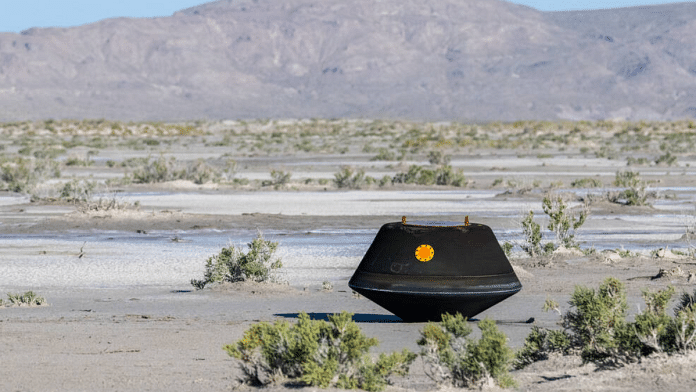Bengaluru: A first for NASA and only the third for humanity, a space capsule containing samples of an asteroid 82 million kilometres away from Earth landed in the United States’ Utah desert — marking the historic climax of a seven-year long mission.
The American space agency’s OSIRIS-REx mission, launched in 2016, dropped off the sealed capsule containing the sample from the asteroid it had orbited, called 101955 Bennu, on Sunday. The craft then moved on to study its new target, 99942 Apophis asteroid, which it will reach in 2029.
Analysis of the rare sample is expected to provide information about the evolution of the solar system, and life.
Bennu orbits the Sun between Mars and Earth. It is categorised as a “near-Earth” asteroid, and could potentially collide into Earth a few centuries later. It is a carbonaceous asteroid, rich in organic molecules, and, therefore, analysis of the samples is expected to provide clues to the origin of life.
In a press conference following retrieval of the sample Sunday afternoon, NASA scientists and engineers called it an “amazing treasure trove for generations”. They now aim to ensure the sample remains pristine and uncontaminated by biological entities during analysis.
While this is entirely a NASA mission, the analysis will involve collaboration with Japanese scientists as well. The Japanese space agency, JAXA, had previously shared the two samples it had retrieved from two different asteroids with NASA.
The OSIRIS-REx mission, which began its journey to Bennu in 2016, collected the sample in 2020 before heading back to Earth.
The Bennu sample containing at least 60 gm material from the asteroid was retrieved by explosives experts and taken to a clean room for analysis.
This sample return is the first for NASA, but the third overall sample return from asteroids to Earth after Japan’s Hayabusa 1 and 2 returned samples from near-Earth asteroids 25143 Itokawa and 162173 Ryugu in 2010 and 2018, respectively.
Also Read: ‘No signals received,’ says ISRO as space agency tries to wake up moon mission’s lander, rover
OSIRIS-REx mission
The full name of the extended OSIRIS-REx mission is now OSIRIS-APEX, which is an acronym for Origins, Spectral Interpretation, Resource Identification, Security, APophis EXplorer. The REx part of the name earlier stood for “regolith explorer”.
The spacecraft entered the 560m-wide Bennu’s orbit in December 2018, going around the asteroid for two years analysing the surface and finalising a landing spot.
In October 2020, it touched the asteroid’s surface to extract a sample for which the spacecraft lowered itself close to the asteroid’s surface and extended out a robotic arm called the Touch And Go Sample Acquisition Mechanism (TAGSAM).
When the arm contacted the surface, high pressure nitrogen gas was released below to blow the regolith or surface particles into the sample collector on the arm. After five seconds, the arm was retracted, and a sample was shown to have been collected in the arm.
The mission was intended to collect at least 60 gm of material from the asteroid, and NASA in 2020 had stated that they have been able to collect between 400 gm and 1 kg of material.
The sample was then sealed inside the return capsule, and the spacecraft prepared to return to Earth. In April 2021, the spacecraft completed its final flight around Bennu, and in May, it began its journey towards Earth.
The $800 million USD mission is a part of NASA’s New Frontiers programme, which also includes the Juno mission around Jupiter and the New Horizons mission, which flew by Pluto.
OSIRIS-REx will rendezvous (meet) with the asteroid Apophis in April 2029 and orbit it for 18 months. While it is not expected to return a sample, it will perform a similar surface-disturbing manoeuvre to study the material beneath.
Near-Earth asteroids
Asteroids like Bennu, Itokawa, Ryugu, and Apophis are classified as near-Earth objects (NEOs) because their orbit around the Sun brings them close enough to Earth for them to be monitored for potential collisions in the future.
This distance is thought to be 1.3 astronomical units from the sun, where the distance of Earth to Sun (150 million kilometres) is one astronomical unit (au).
Near-Earth objects are mostly asteroids but can sometimes also be comets.
If an object crosses Earth’s orbit and is larger than 140 m in diameter, it is considered a potentially hazardous object (PHO).
There are over 30,000 near-Earth asteroids that are actively monitored. NEOs typically have low surface gravity as they are comparatively smaller rocks than planets, extending in mere metres to kilometres in diameter.
Five of these near-Earth asteroids have been visited up close by spacecraft — NASA’s NEAR Shoemaker orbited and landed on 433 Eros in 2001-02, and China’s Chang’e 2 lunar mission flew by 4179 Toutatis in 2012. Japan also visited Itokawa and Ryugu, and the US brought back a sample from Bennu.
Apophis, OSIRIS-APEX’s new destination is a silicate and rocky asteroid, quite different from Bennu in structure and composition. It is a PHO with a diameter of 370 m.
Apart from studying the composition of the rocks for clues to the origin of the solar system and life, scientists have also performed a planetary defence experiment to protect the Earth from an approaching asteroid.
Large enough asteroids on a collision course towards Earth can theoretically be deflected in their orbit to move away by a slight collision. This was demonstrated in the NASA DART mission last year, where a spacecraft was sent to the (harmless) asteroid Didymos and impacted its moon Dimorphos to change its orbit successfully.
(Edited by Richa Mishra)
Also Read: Fairly good chance that Vikram & Pragyan will wake up on moon, says former ISRO chief



